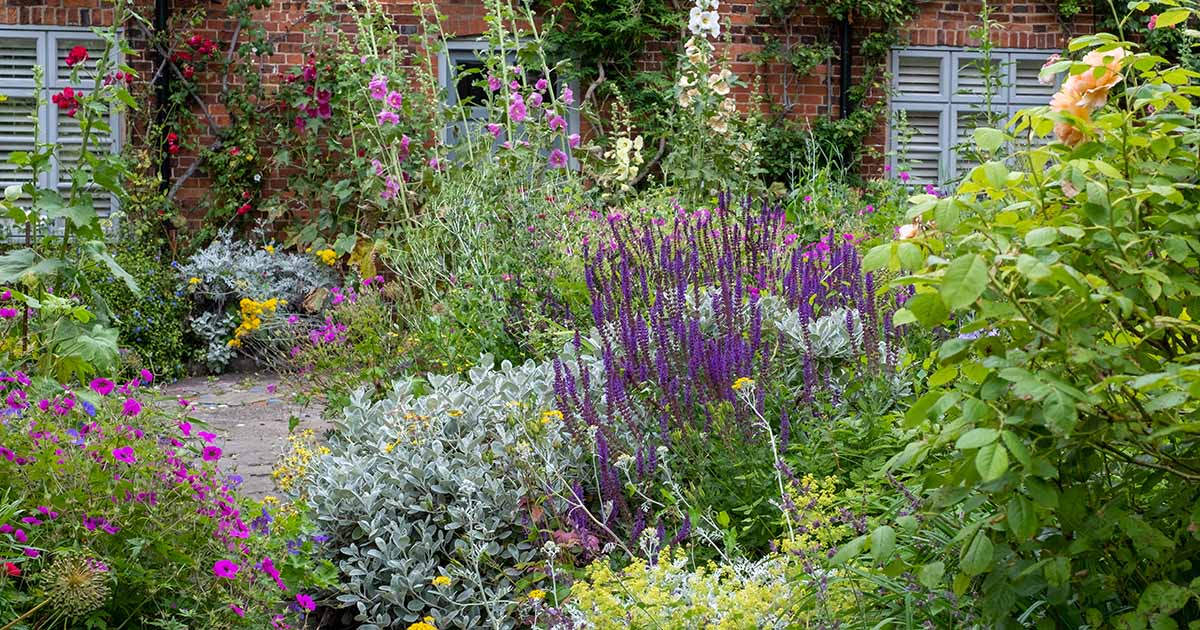
Do you feel pressured to keep up your lawn and tidy border plants and wish your vista was less exacting and more fun?
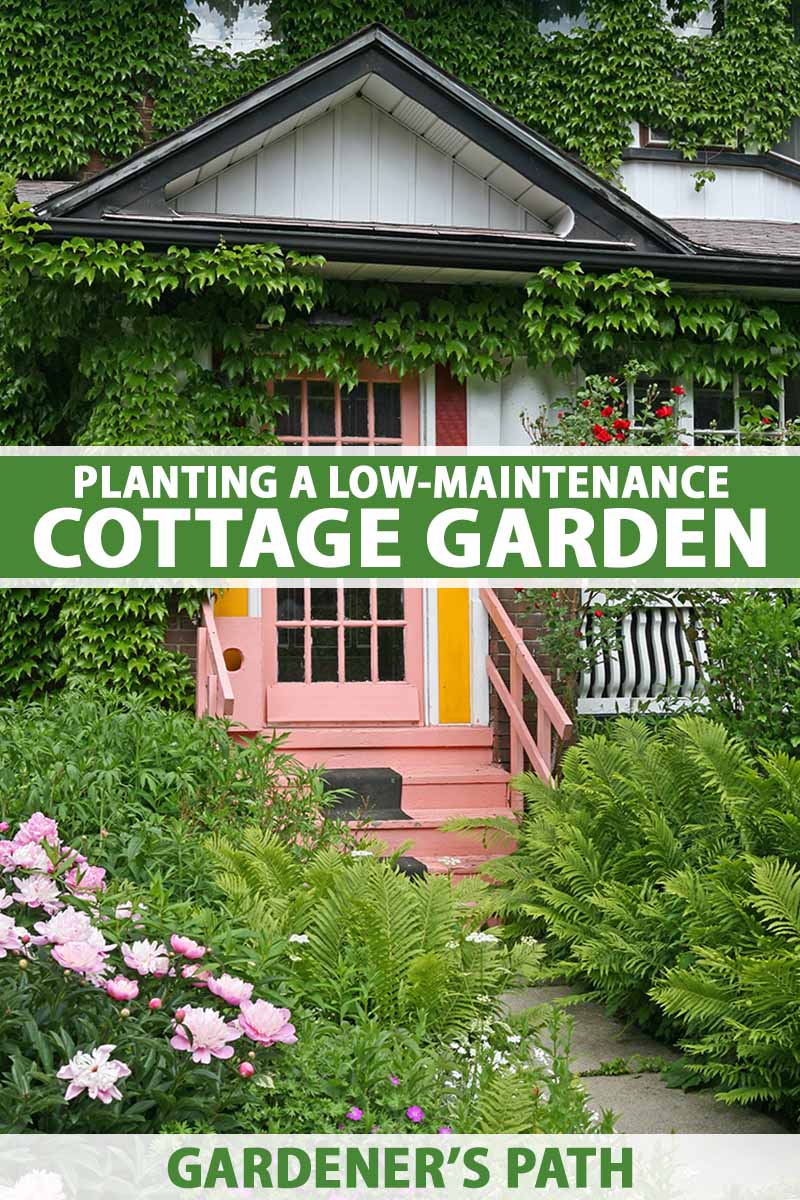
We link to vendors to help you find relevant products. If you buy from one of our links, we may earn a commission.
Forget the well-behaved rows of marigolds and sea of green and read on to turn picture-perfect drudgery into a lush, meandering, delightfully unfussy cottage garden!
Here’s what we’ll cover:
Here’s how to make it happen!
The Evolution of the Cottage Garden
Cottage gardens of the 17th and 18th centuries were functional rather than ornamental and gave England’s rural poor a way to sustain themselves with vegetables, herbs, fruits, flowers, and animals.
Dense planting optimized the small spaces they encompassed.
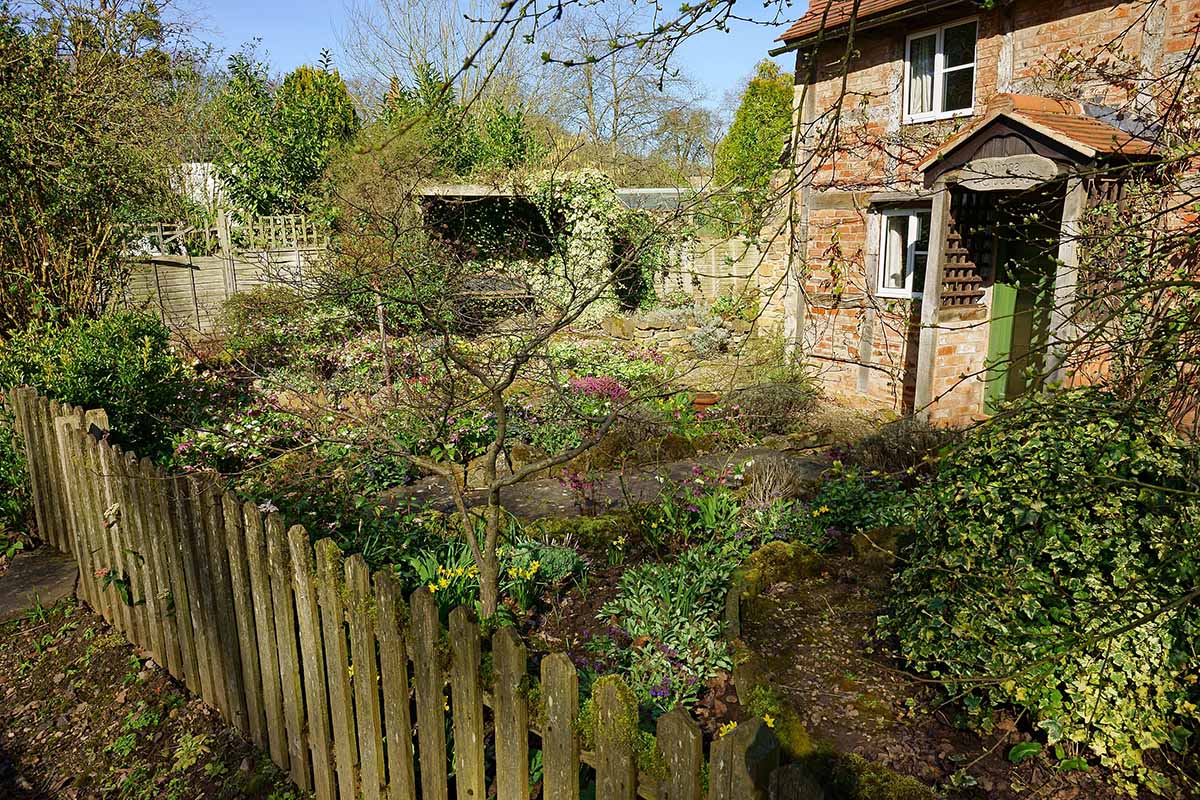
When members of the landed gentry took an interest in horticulture, they looked to the cottage style for inspiration, planting flouncy blooms for pure pleasure, creating vantage points from which to enjoy the view upon a bench or when rounding a curve on a winding path.
Colonial Americans called their plots kitchen gardens and grew similar fare to sustain their families. As in England, growing plants for beauty rather than function appealed to those with higher income and more leisure time.
Garden design evolved on both sides of the pond to include formal arrangements of hedges and lawns, and informal displays of native species in naturalistic settings.
Today’s best cottage gardens incorporate the functionality of the early English and American household plots, the structure of formal spaces, and the informality of native plantings.
Contrary to what some may think at first glance, they are not unplanned and chaotic but contrived to achieve a dense, lush feast for the senses.
Planning Today’s Cottage Garden
Not everyone likes this gardening style, and in some communities, the abandonment of a lawn for the apparent disarray of a floral extravaganza meets with disapproval.
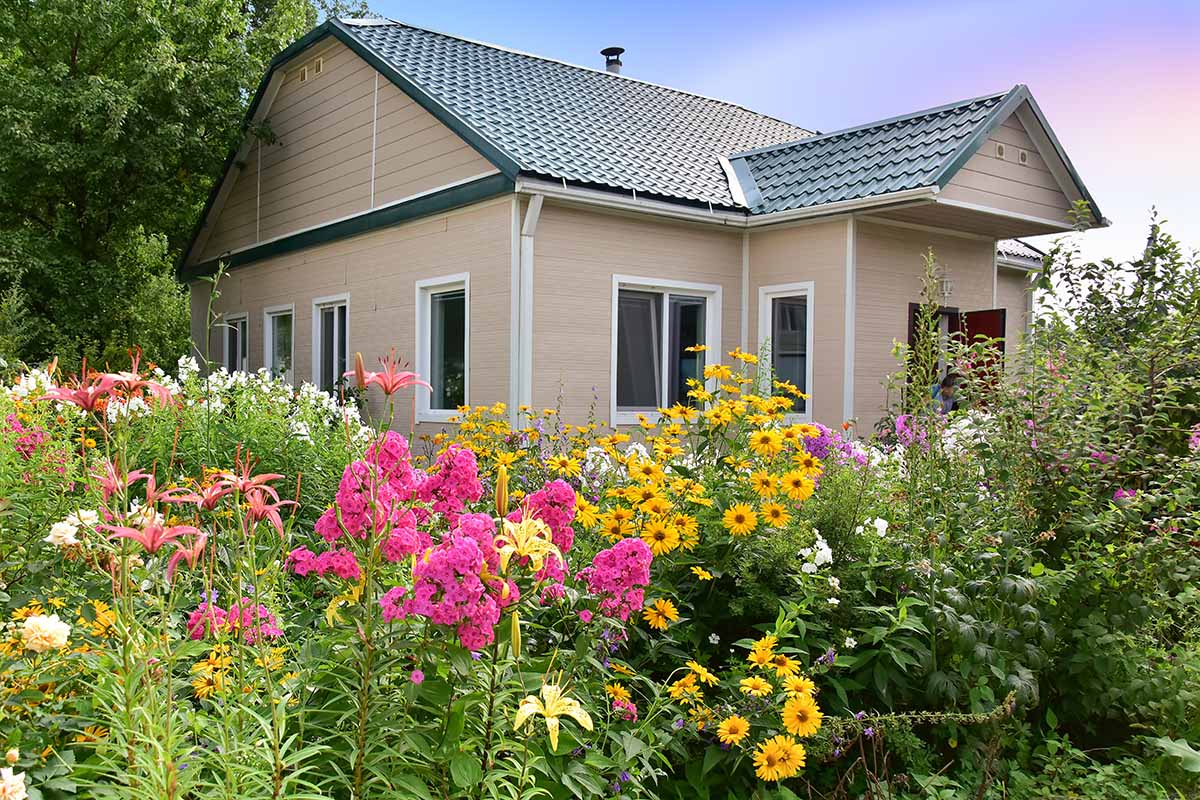
If you live in a planned community and are responsible for your lawn care, be sure to check with the HOA before undertaking a large-scale landscaping style change or you risk unwelcome repercussions.
If you’re ready to convert some or all of your lawn space to cottage gardening, here are some tips for success:
1. Choose native species whenever possible. Plants native to your region readily adapt to their surroundings, are less prone to pests and disease, and typically require less water than non-natives.
2. Control weeds and create no-mow pathways with a selection of ground covers. Choose those suited to foot traffic or full or partial shade beneath taller specimens, depending on the location.
3. Mix heights, shapes, and colors for visual interest. Repeat a single color sporadically throughout for a pleasing rhythm.
Choose round, flouncy blooms, tall blossom spikes, and variegated foliage to draw the eye into your design.
Combine flowers, foliage, fruit, herbs, and vegetables as desired per their cultural requirements.
4. Incorporate fragrant species for additional sensory appeal.
5. Jumpstart your design with transplants rather than starting from seed. Perennials last longer, but annuals offer the opportunity to change plants yearly. Use either or both in your scheme.
6. Read all available species and cultivar information to determine suitability for your growing zone, soil requirements, sun and water needs, and mature dimensions.
7. Select pest- and disease-resistant varieties and those described as “low-maintenance.”
8. Space plants at the minimum recommended distance to achieve full, dense appearance.
Goodbye Grass!
If you’re ready to take the plunge and change some or all of your lawn over to plants, there are a couple of ways to do it.
The quickest way to get rid of your lawn is to rent a tiller to cut through the sod and churn it up. Let the clumps dry in the sun, then break them up.
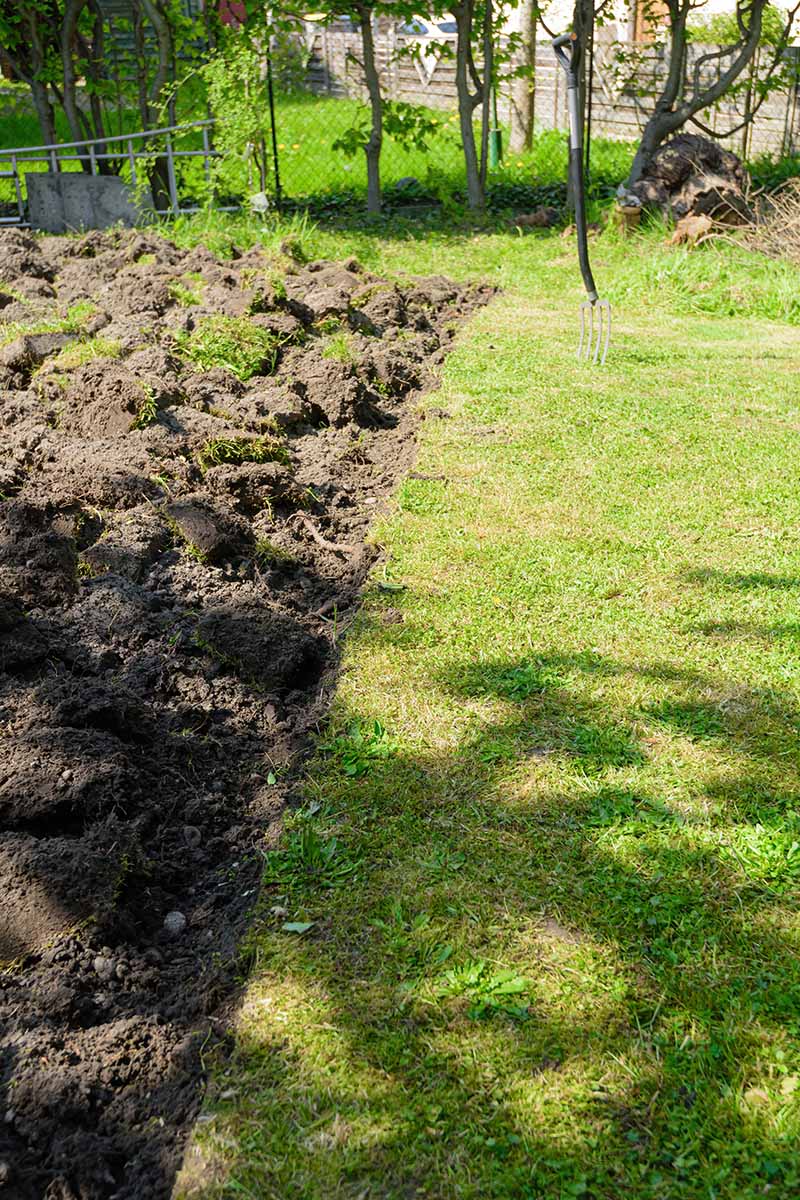
If you are especially strong, you can dig up the grass by hand instead of tilling it.
And if you’re not in a hurry, you can spread black landscaping fabric over the area you want to de-turf. Weigh it down with bricks or rocks and let the sun heat it for a few weeks. Remove it when the grass below is brown and dead, and then dig up the grass.
Once you remove the lawn, work the soil to a depth of 12 to 18 inches, removing all signs of grass and roots to avoid re-establishment.
Amend the soil by working in a three-inch layer of rich organic matter like compost or leaf mulch. If you want to be more precise with your nutrients and learn the pH level, contact your local extension office for a soil test.
If you want to replace your entire lawn with plants, you can opt to take it slowly by planting a few square feet at a time or go all in.
If you do leave a large expanse of ground bare, be sure to cover it with weed-free straw during the garden installation to prevent the soil from washing away during heavy rain.
With the ground ready, it’s time to think about how you’ll walk through the garden and whether you’d like to have seating areas.
The worst is over. The grass is gone, and the soil is ready. Now, let’s focus on setting the stage for lush flora.
Anchoring the Space
Trees, shrubs, seating, and paths are key structural elements that anchor the overall design around which plants are installed.
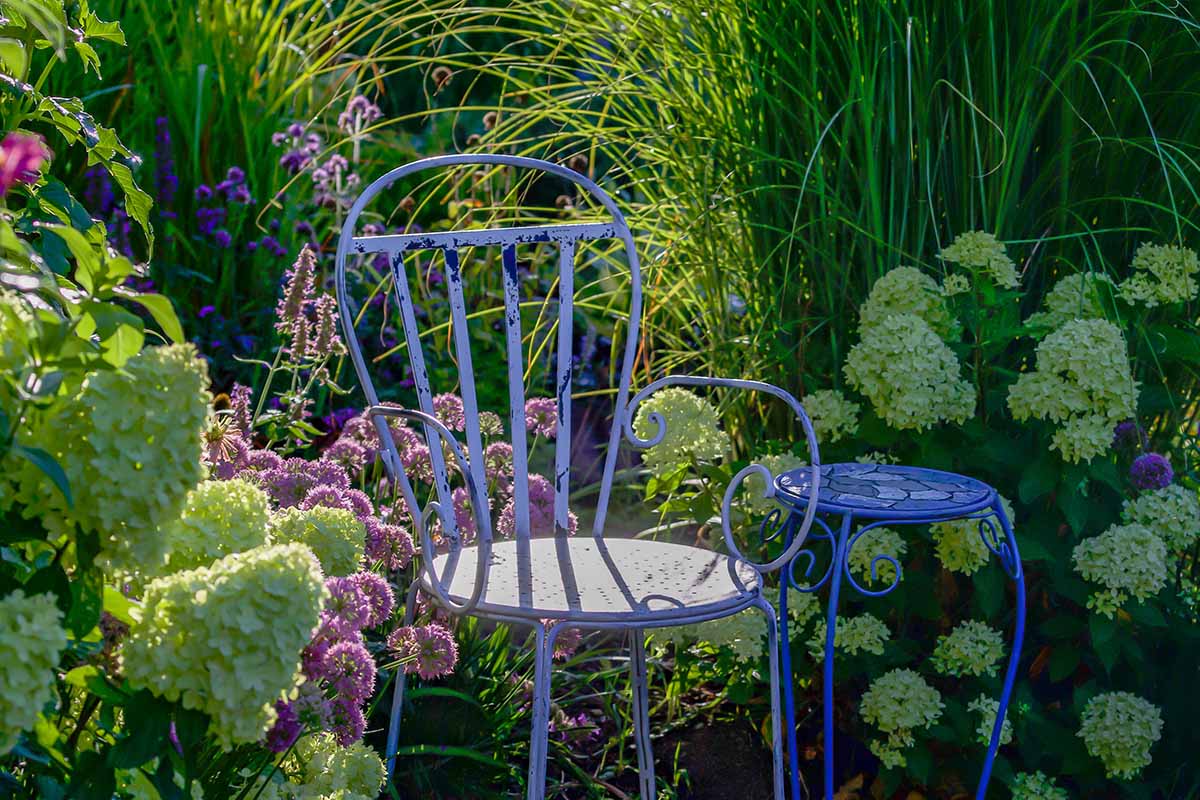
When selecting trees and/or shrubs, review the mature dimensions to avoid overpowering and entirely shading a small space.
Lay out paths and place seating as desired.
Use graph paper to sketch a scale model of your design.
From which direction do you want to enter the garden? Will you walk straight through or turn and walk back?
You may want a single path that bisects the growing area and ends at a bench, for example.
Should it face the house? The setting sun?
Will you sow a ground cover for your path or hardscape it with gravel, bricks, slates, or the like?
Place your large tree and shrub anchors in a visually balanced scheme around the design.
For example, place a tree in the center and three shrubs in a triangular arrangement around the perimeter of the space.
Before we move on to selecting plants, there’s another consideration: watering. Even if you choose water-wise native species, you’ll have to keep them moist while they become established and during dry spells.
One way for busy gardeners to save time and energy is to install an in-ground irrigation system before setting the plants in the ground.
Selecting Plants
A cottage garden is a small world of plants that complement one another, and typically includes varieties like dwarf shrubs and trees, flowering vines, and perennials.
Which to choose depends upon factors like your USDA Hardiness Zone, sun exposure, and soil type.
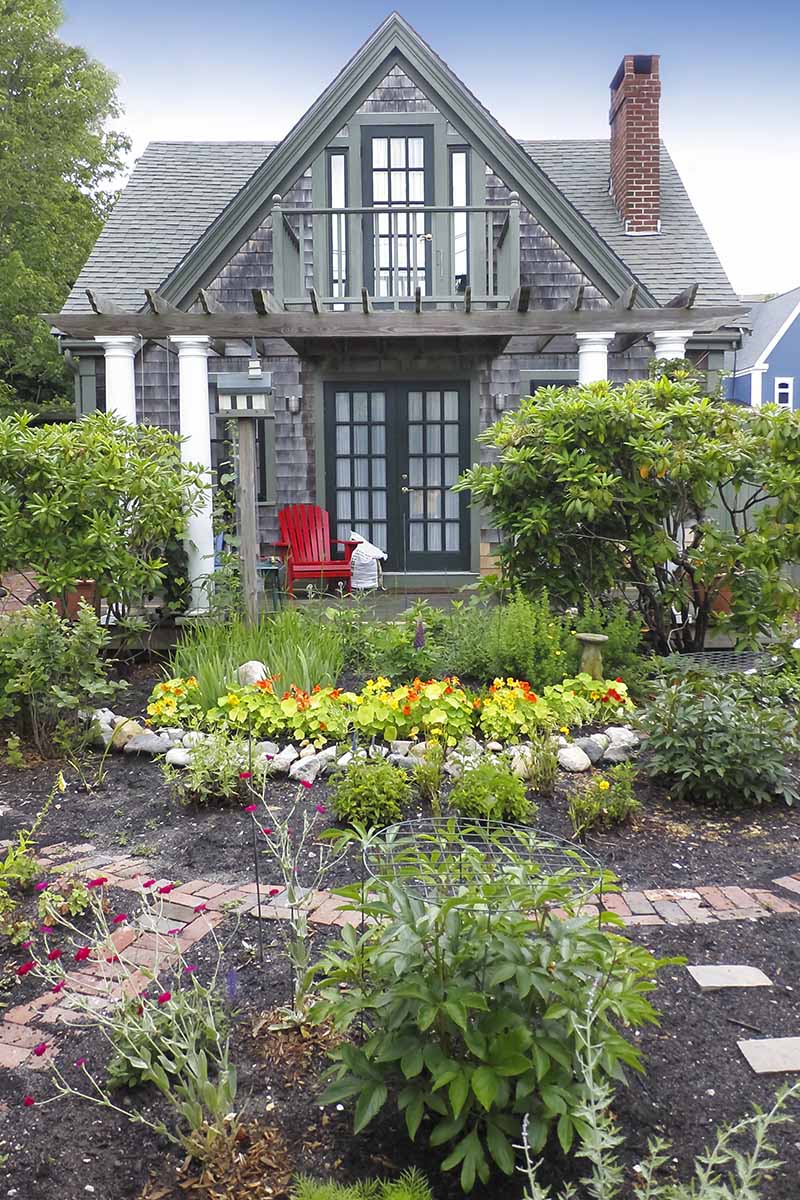
If you select native species suitable for your region, you’ll find they grow reliably and require less supplemental water than non-natives.
And if you choose ornamental fruit trees, you’ll have beauty without fruit to harvest.
To achieve a cottage garden ambiance, focus your search on flora with large, flouncy “old-fashioned” flowers, lush foliage, and fragrance.
Here are some classic options from which to choose:
Annuals:
Biennials:
Bulbs:
Climbers and Creepers:
Herbs:
Perennials:
Shade Lovers:
Shrubs:
Trees:
Vegetables:
Interplant compatible ornamentals and edibles that have the same growing requirements.
Then all you need is a cow, some chickens, and perhaps a pig or two, and you’ve recreated a real old-fashioned cottage garden!
Jot down your favorite bloomers, edibles, foliage plants, and woody specimens.
Consider bloom time, growth rate, tendency to naturalize and spread, form, color, texture, and potential for beauty in all seasons, including bare stem winter interest.
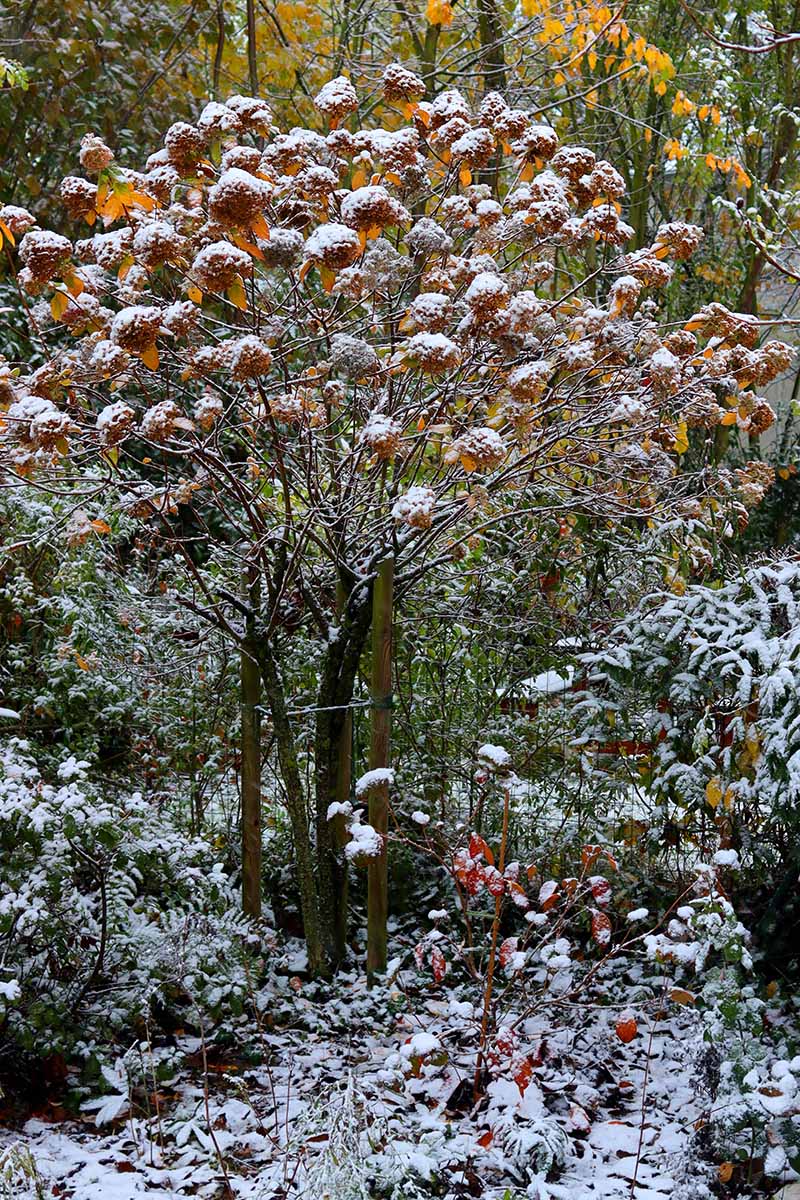
And note that if there’s a species you love that’s not suited to your growing zone, you may be able to grow it as an annual or potted specimen to bring indoors for the winter.
Look for these details during your research.
When you’ve made your selections, it’s time to arrange them.
Planting Tips
Begin by making a graph paper representation of each selection.
Imagine that you are looking at it from above, and cut out a circle for each that is a scale model of its expected width at maturity.

For example, if each square of your graph paper equals six inches, an aster that is 24 inches wide at maturity requires a circle four blocks wide.
A drawing compass, aka pencil compass is a useful low-tech tool that’s ideal for drawing the circles.
On each circle, note the mature height for reference.
Arrange the plants in odd numbers – three or five – to show them to best advantage. Mix species as desired.
For continuity, you can create an eye-catching pattern – for example, use a pink flowering species in each grouping.
If you mix heights, place taller specimens toward the center of the grouping for visual appeal and to avoid obscuring plants that are smaller in stature.
Plan for some flora to overhang your path a bit when they mature to suggest an atmosphere of abundance and casualness.
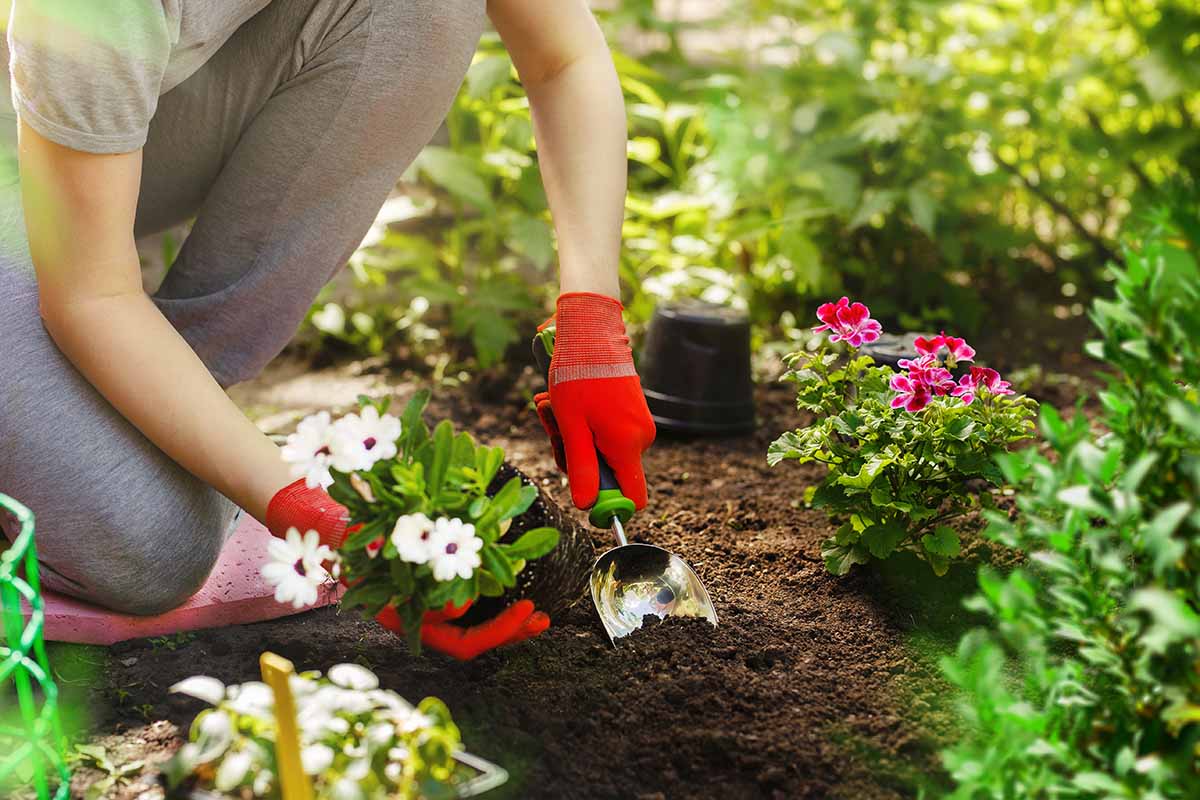
Once you have a plan on paper, you can physically place all of your plants in their locations and adjust them as desired.
Be sure to make corresponding changes on your graph paper so you have an accurate record of what you are growing and where.
When you are ready to install flora, remove and discard any straw or mulch you used to cover the soil while it was fallow.
Work the ground with a garden rake to loosen it to a crumbly consistency. Remove and discard any debris.
Take note of the depth each plant sits in its original container. You’ll want to replicate it when you put it in the ground.
For shrubs and trees, make a hole as deep as the root ball and two to three times as wide.
Set each plant appropriately, backfill, and tamp firmly.
Water well with the garden hose or your newly installed irrigation system if you opted for one.
And now, the finishing touches: accessories.
Accessorizing
With large anchor trees and shrubs, paths, seating, and ornamental species in place, you have established a cottage garden.
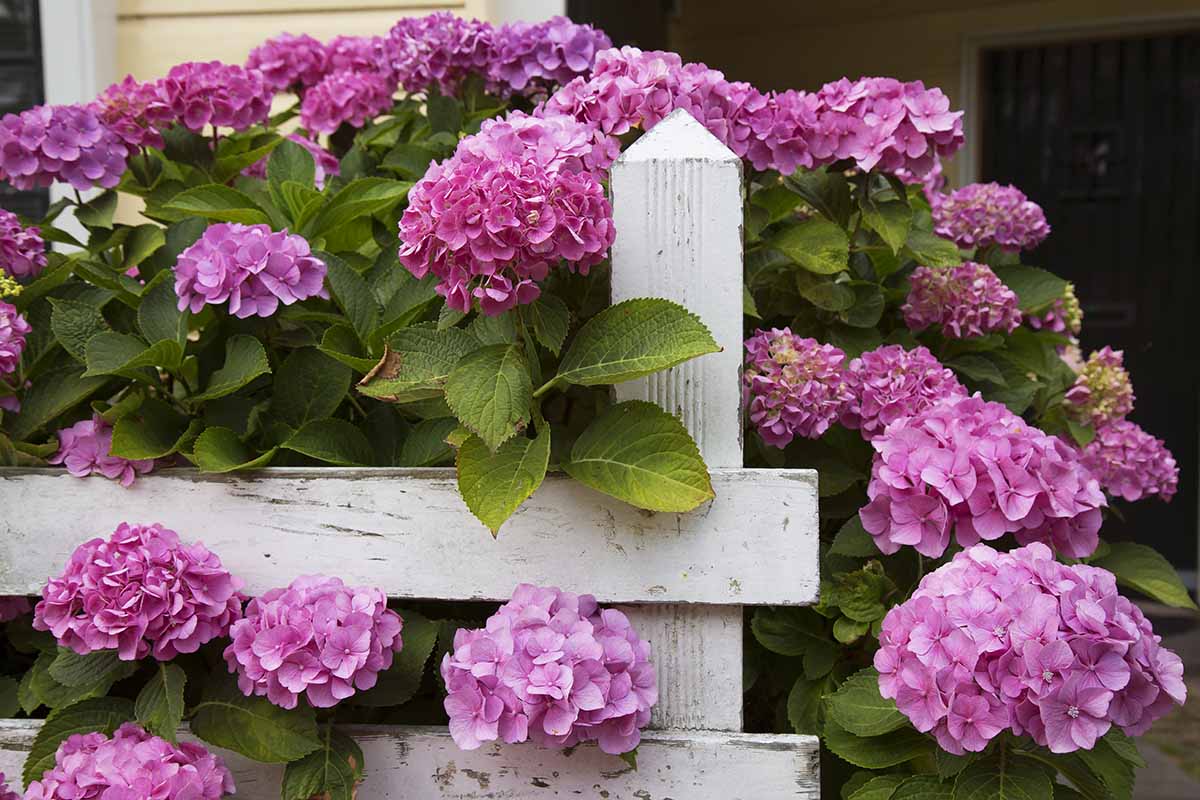
Use mulch to cover any ground that is currently bare to inhibit the growth of weeds. In time, the flora will grow, filling in gaps and providing dense layers of texture, form, and color.
For a final cozy touch, you can add some or all of the following embellishments:
- Gazing Ball
- Picket Fence
- Sculpture or Statue
- Table
- Trellis
How much or little you add is a matter of preference and the size of your space. When selecting items, choose those intended to withstand outdoor conditions year-round.
Over time, natural materials will weather delightfully and display patinas with an ages-old appearance.
When you incorporate wildlife-welcoming elements, you increase the habitat value of your property.
Vertical pieces like an arbor or trellis draw the eye upward and increase visual interest.
Finally, have support materials like stakes, twine, and tomato cages on hand to use as needed to inhibit the flopping over of any plants with leggy stems.
Maintaining the Ambiance
Contrary to the belief of some, today’s cottage garden can be a carefully organized compilation of free-spirited blooms, foliage, shrubs, and trees, rather than a tangled mass of miscellaneous flora in perpetual disarray.
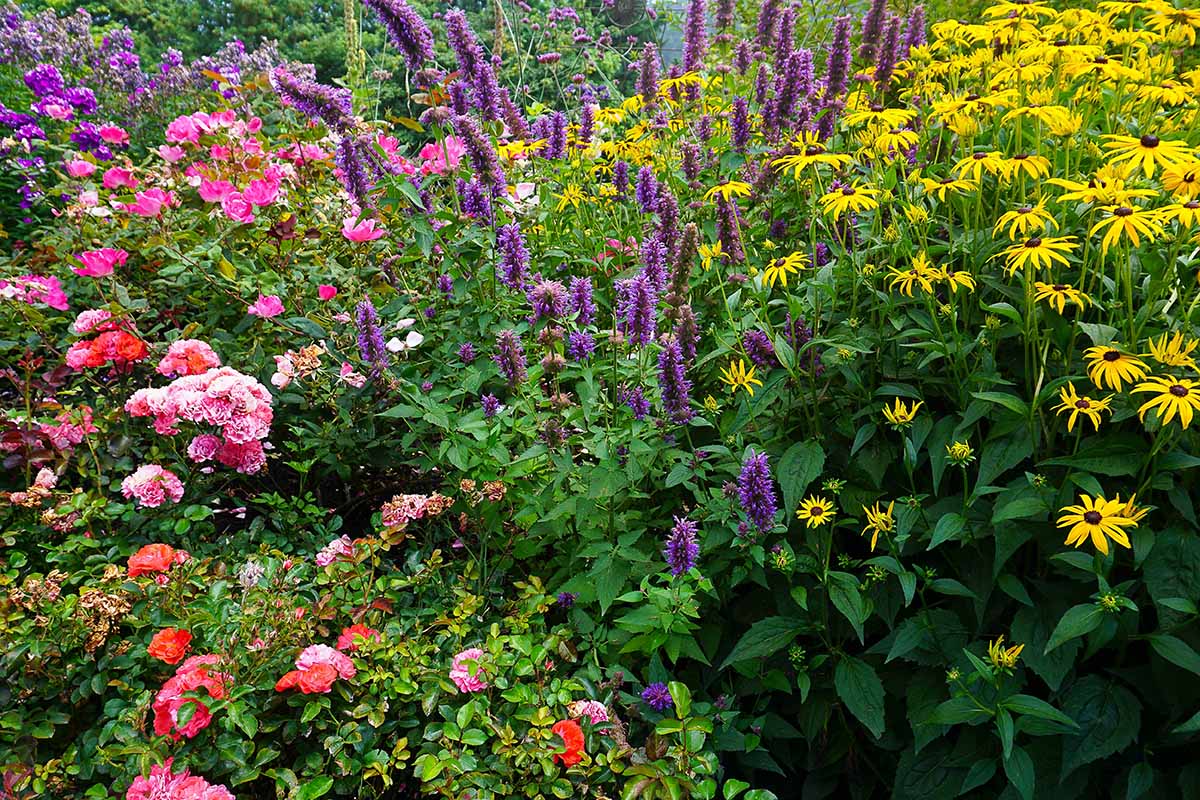
The maintenance needed depends upon the requirements of the plants you have chosen.
Perennials may benefit from deadheading to prolong blooming and dividing to maintain a compact form and manageability.
Annuals will need to be replaced yearly, providing the opportunity to vary your plantings.
At the end of the growing season, some folks like to let native species wither and remain in place to save some seeds, feed late-season birds, and provide winter interest.
They clean up the remaining debris in late winter to early spring.
Others like to cut down all spent stems at the end of the growing season to keep the garden tidy and to make way for fresh spring growth.
The degree of precision versus loosey-goosey casual is entirely up to you.
In addition, it’s worth noting that dense plantings are more prone to fungal conditions, so it’s essential to avoid overwatering and to divide plants that outgrow their designated space and encroach on others.
General rules of thumb for watering and fertilizing are:
Provide an inch of water per week if it doesn’t rain and more during a prolonged dry spell.
Fertilize in early spring when new shoots appear. Use a balanced 10-10-10 (NPK) product and apply it near but not touching soft stems and woody trunks.
As mentioned, the specific information about each plant is your best guide, and sowing those with similar cultural requirements makes care one-size-fits-all.
Soul-Satisfying and Serene
Whether you have an eye for the whimsical or the practical, a cottage garden is a departure from the mundane and a foray into a less prescriptive, more soul-satisfying greenspace experience.
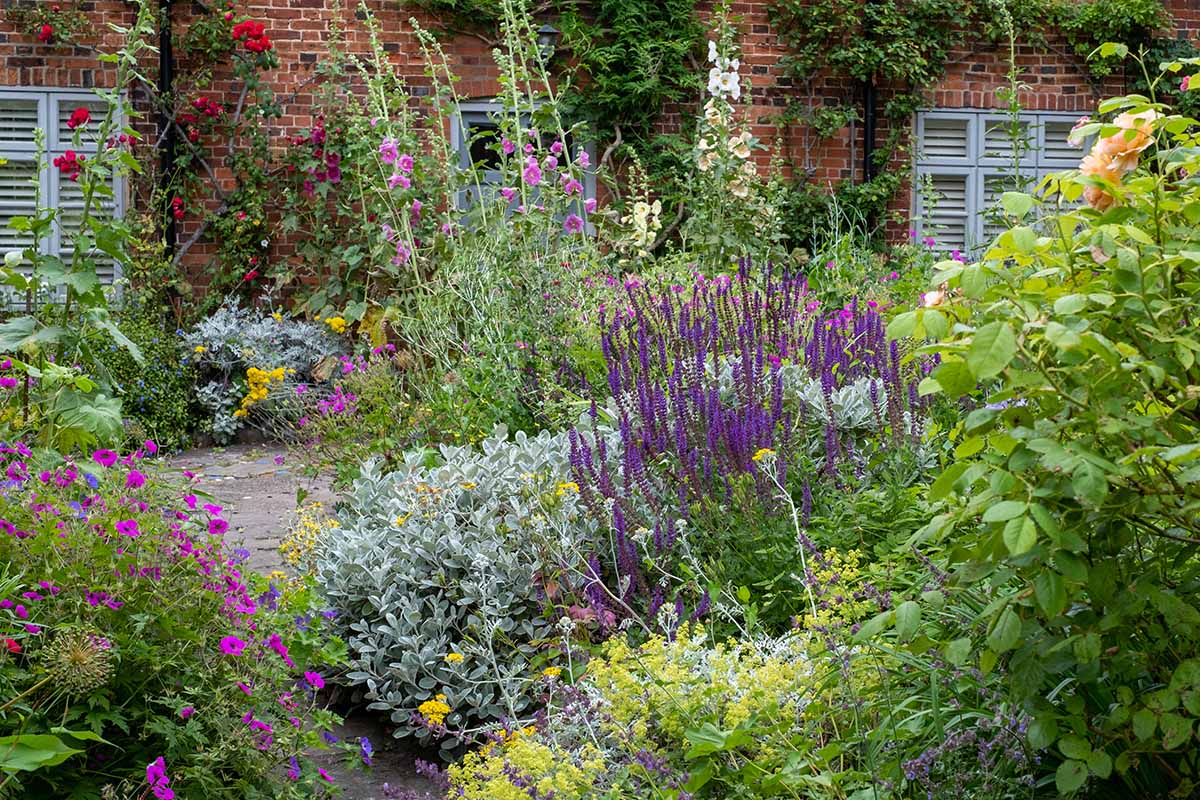
Park your mower and immerse yourself in the serenity of a cottage garden you created yourself.
Do you have a cottage-style garden? What tips can you offer to streamline maintenance? Please share them in the comments section below.
If you found this guide helpful and want to learn more ways to simplify your gardening routine, we recommend the following guides next:





